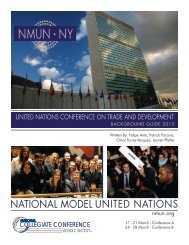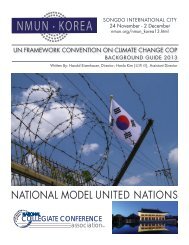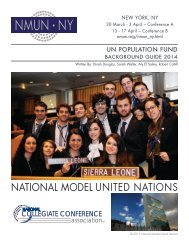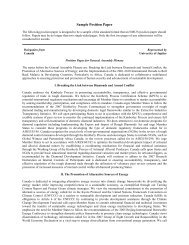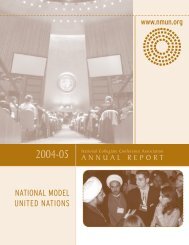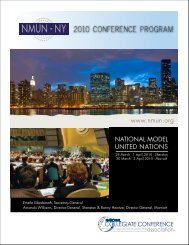Organization of American States - National Model United Nations
Organization of American States - National Model United Nations
Organization of American States - National Model United Nations
You also want an ePaper? Increase the reach of your titles
YUMPU automatically turns print PDFs into web optimized ePapers that Google loves.
Migrant Workers and Protection <strong>of</strong> Rights<br />
Protecting the labor rights <strong>of</strong> migrant workers is no longer an economic concern for host and home countries, but<br />
also a human rights issue. 87<br />
Often times migrant workers labor rights go unnoticed and are continuously violated because they are not considered<br />
to be part <strong>of</strong> the actual workforce. 88 This is an ethical and moral dilemma and because “countries are more apt to<br />
focus on issues <strong>of</strong> border security, employer sanctions and criminalization <strong>of</strong> migration as ways to address their<br />
migration issues this approach ignores the human rights <strong>of</strong> migrants themselves, as well as a powerful tool to reduce<br />
employer incentives to hire and exploit migrant workers.” 89<br />
OAS Measures & International Legal Frameworks to protect labor rights<br />
The <strong>Organization</strong> <strong>of</strong> <strong>American</strong> <strong>States</strong> (OAS) was created to promote unity and collaboration amongst Member <strong>States</strong><br />
and to protect sovereignty, human rights, and independence <strong>of</strong> states in the region. 90 Many migrant workers migrate<br />
to and from across the Inter-<strong>American</strong> region and from one OAS Member State to another. 91 Protections <strong>of</strong> Migrant<br />
Workers are high on the OAS agenda. Migrant workers are identified as a vulnerable group <strong>of</strong> workers and the<br />
International Labor <strong>Organization</strong> (ILO) constitution, several UN Human Right instruments such as the Convention<br />
on the Rights <strong>of</strong> Migrant Workers call for their protection. 92 The International Convention on the Protection <strong>of</strong> the<br />
Rights <strong>of</strong> All Migrant Workers and their families entered into force July 1, 2003, and it states that protection <strong>of</strong> the<br />
interests <strong>of</strong> workers when employed in other countries other than their own is imperative in Part I, Article 1 and Part<br />
III <strong>of</strong> the Convention, which applies to all migrant workers and their families. 93 The purpose <strong>of</strong> the convention is to<br />
protect the human and labor rights <strong>of</strong> migrant workers. 94<br />
The issue <strong>of</strong> migrant workers and protection <strong>of</strong> their labor rights is a region wide concern and hundreds and<br />
thousands <strong>of</strong> workers who go undocumented each year makes protecting them rights even harder. 95 Unauthorized<br />
immigration, the smuggling and trafficking <strong>of</strong> people, and the protection <strong>of</strong> the rights <strong>of</strong> migrant workers are primary<br />
political and policy problems for almost every country in the hemisphere. 96 As a measure to protect the labor rights<br />
<strong>of</strong> migrant workers and their families the OAS Department <strong>of</strong> International Law has created an Inter-<strong>American</strong><br />
Program for the promotion and protection <strong>of</strong> the Human Rights <strong>of</strong> Migrants, including protection <strong>of</strong> migrant workers<br />
and their families.<br />
Other OAS actions include calling for increasing standards <strong>of</strong> work so that all migrant workers can have ‘decent<br />
work,’ as described in the outcome document from the 4 th Summit <strong>of</strong> Americas (2005). 97 As already mentioned, the<br />
protection <strong>of</strong> the rights <strong>of</strong> migrant workers is a priority on the OAS agenda, and for this purpose, the OAS has<br />
dedicated an entire committee to protect the labor rights <strong>of</strong> migrant workers. 98 The OAS has various functioning<br />
bodies, among which is the Permanent Council <strong>of</strong> the OAS Committee on Juridical and Political Affairs (CAJP). 99<br />
This body has done substantial amount <strong>of</strong> work on the protection <strong>of</strong> labor rights <strong>of</strong> migrant workers. 100 The CAJP, an<br />
OAS initiative was created exclusively for the protection against human rights violation <strong>of</strong> migrants and also played<br />
an integral role in the creation <strong>of</strong> the Inter-<strong>American</strong> Program for the Promotion and the Protection <strong>of</strong> the Human<br />
Rights <strong>of</strong> Migrants. 101 Namely, Resolution 2593 protects migrant workers and their families against human rights<br />
87 The People’s Movement for Human Rights Education, Human Rights and Migrant Workers.<br />
88 International Labor <strong>Organization</strong>. Protecting the Rights <strong>of</strong> Migrants Workers A Shared Responsibility, 2009.<br />
89 Smith, Protecting the Labor Rights <strong>of</strong> all Migrant Workers in the Americas, 2006.<br />
90 The <strong>Organization</strong> <strong>of</strong> <strong>American</strong> <strong>States</strong>. Who we are, 2011.<br />
91 <strong>Organization</strong> <strong>of</strong> <strong>American</strong> <strong>States</strong>, Rights <strong>of</strong> Migrant Workers, 2008.<br />
92 <strong>Organization</strong> <strong>of</strong> <strong>American</strong> <strong>States</strong>, Rights <strong>of</strong> Migrant Workers, 2008.<br />
93 University <strong>of</strong> Minnesota Human Rights Library, International Convention on the Protection <strong>of</strong> the Rights <strong>of</strong> All Migrant<br />
Workers and Their Families, 2003.<br />
94 University <strong>of</strong> Minnesota Human Rights Library, International Convention on the Protection <strong>of</strong> the Rights <strong>of</strong> All Migrant<br />
Workers and Their Families, 2003.<br />
95 Smith, Protecting the Labor Rights <strong>of</strong> all Migrant Workers in the Americas, 2006.<br />
96 Smith, Protecting the Labor Rights <strong>of</strong> all Migrant Workers in the Americas, 2006.<br />
97 <strong>Organization</strong> <strong>of</strong> <strong>American</strong> <strong>States</strong>, Rights <strong>of</strong> Migrant Workers, 2008.<br />
98 <strong>Organization</strong> <strong>of</strong> <strong>American</strong> <strong>States</strong> Committee on Juridical and Political Affairs, Special Committee on Migration.<br />
99 <strong>Organization</strong> <strong>of</strong> <strong>American</strong> <strong>States</strong> Committee on Juridical and Political Affairs, Special Committee on Migration.<br />
100 <strong>Organization</strong> <strong>of</strong> <strong>American</strong> <strong>States</strong> Committee on Juridical and Political Affairs, Special Committee on Migration.<br />
101 <strong>Organization</strong> <strong>of</strong> <strong>American</strong> <strong>States</strong>, Political Processes Juridical and Political Affairs Committee (CAJP), 2011.



